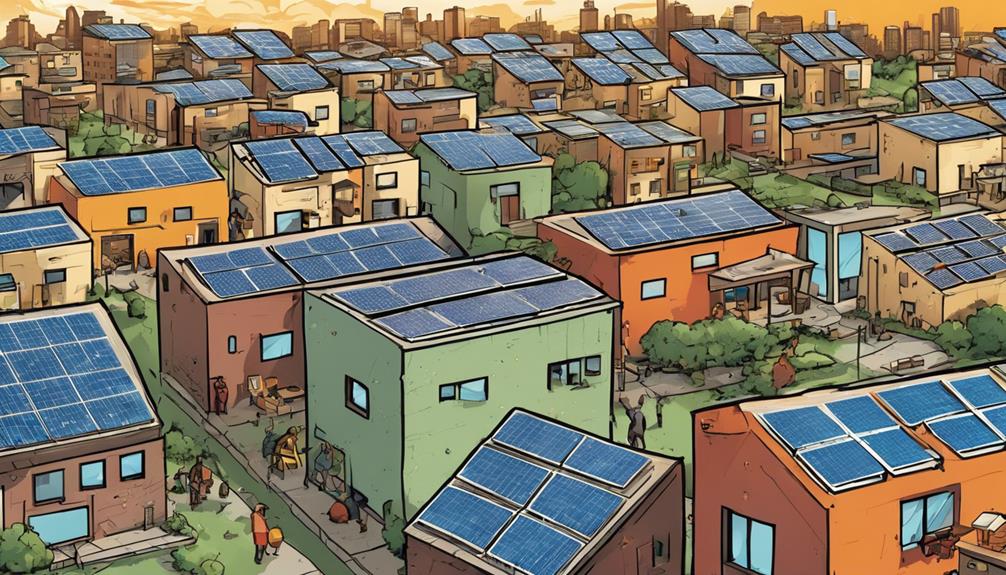To expand solar energy use, consider utilizing incentives such as tax credits and rebates, and exploring advancements in solar technology like flexible solar cells. Educate the public on solar benefits and support policies that incentivize solar integration across sectors. Embrace solar in new construction regulations, including rooftop panel installations. Overcoming challenges involves addressing costs and energy storage limitations. Discover strategies like streamlining permits and investing in research to push solar energy growth further. This all-encompassing approach leads to a brighter solar-powered future.
Key Takeaways
- Increase solar incentives like tax credits.
- Simplify permitting processes for solar installations.
- Invest in solar research and development.
- Implement community solar programs for wider access.
- Promote solar panel recycling to reduce waste.
Incentives for Solar Adoption
To encourage the adoption of solar energy, consider taking advantage of various incentives available in your area. Incentives like tax credits and rebates can greatly reduce the upfront costs of installing solar panels for both homeowners and businesses.
Some states also offer net metering programs, allowing solar users to sell excess energy back to the grid, making solar energy even more cost-effective. Additionally, solar renewable energy certificates (SRECs) provide financial incentives for producing solar power, further motivating the switch to renewable energy sources.
Property-assessed clean energy (PACE) financing is another option that allows property owners to finance solar installations through property taxes, spreading out the cost over time.
It's essential to research the specific incentive programs available in your location since these programs can vary greatly from state to state. By taking advantage of these incentives, you can make the shift to solar energy more affordable and environmentally friendly.
Research and Development in Solar Technology

Consider the advancements in solar technology research, focusing on innovative developments like flexible CQD solar cells and wearable solar-powered devices with extended mobility and power storage capabilities. Researchers are making strides in the field of solar technology by developing flexible CQD solar cells that can be sprayed onto batteries, creating integrated power systems.
Additionally, the focus is on designing wearable solar-powered devices that offer extended solar mobility and enhanced power storage capabilities. Photobatteries, which combine quantum dots with metal-organic frameworks, are being explored to store solar energy independently, significantly extending battery mileage.
Collaboration with the Applied Physics Lab (APL) is playing an essential role in enhancing research on portable power generation for sustainability efforts. Through APL, researchers have access to cutting-edge facilities such as dry rooms and battery synthesis labs, supporting the expansion of solar energy research and development in the quest for more efficient and portable solar technologies.
Public Education on Solar Benefits

Increasing public awareness about the benefits of solar energy is vital for promoting clean energy adoption and sustainability. Educating the public on the advantages of solar energy, such as cost savings and environmental impact, is important for encouraging more people to contemplate switching to clean energy sources.
By providing information on solar incentives, rebates, installation, and maintenance, individuals can make informed decisions about integrating solar energy into their lives. Utilizing schools, community centers, and online resources for public education campaigns can effectively reach a wide audience and empower communities to embrace solar energy solutions.
Policy Promotion of Solar Integration

Government support for solar integration is vital in driving widespread adoption and implementation of solar energy initiatives across sectors. Policy promotion plays a key role in incentivizing the use of solar panels for power generation in residential, commercial, and industrial settings.
By implementing initiatives that support solar integration, policymakers can encourage investment in solar infrastructure and research, ultimately enhancing the utilization of solar energy. Through the creation of regulations that promote the development of solar projects and increase renewable energy targets, governments can markedly reduce greenhouse gas emissions and decrease reliance on fossil fuels.
Policy promotion of solar integration not only fosters sustainability but also contributes to the growth of a clean energy economy. By actively supporting and promoting solar energy policies, governments can pave the way for a more environmentally friendly and energy-efficient future.
Solar in New Construction Regulations

You should consider how new construction regulations are shaping the future of sustainable energy.
Building codes now often require the installation of solar panels on rooftops to meet energy production targets.
These mandates play an essential role in promoting the use of solar energy in new constructions.
New Construction Solar
When building new structures, incorporating solar energy systems is now a necessary requirement in many regions to promote sustainability and reduce reliance on traditional power sources.
By integrating solar power generation into new constructions, there's a significant opportunity to expand solar energy utilization and decrease the carbon footprint associated with electricity production. These requirements not only facilitate the adoption of renewable energy practices but also contribute to the overall growth of the solar energy industry.
Solar panels on new buildings play an essential role in lowering carbon emissions, fostering energy independence, and supporting sustainable energy initiatives.
Some regions have established building codes that mandate a minimum percentage of solar energy generation capacity in new constructions, reinforcing the commitment to progressing towards cleaner energy sources.
Embracing new construction solar regulations is a vital step towards achieving renewable energy goals and advancing environmental sustainability in the built environment.
Building Code Requirements
Implementing building code requirements for solar in new construction regulations promotes sustainability by mandating the integration of solar panels into building designs. These regulations guarantee that new buildings incorporate solar panels as part of their energy generation strategy.
By making it a requirement to include solar panels in new construction projects, building code requirements drive the adoption of solar energy and contribute to reducing greenhouse gas emissions.
States like California have taken a proactive approach by setting ambitious goals for the integration of solar energy in new construction. Compliance with these regulations not only helps in meeting these goals but also fosters sustainable energy practices.
Sustainable Energy Mandates
Sustainable energy mandates in new construction regulations mandate a certain percentage of energy to be sourced from renewable sources like solar power. These regulations play an important role in reducing greenhouse gas emissions and encouraging sustainable energy practices within the building sector.
The integration of solar power requirements into building codes has become increasingly common across various cities and states, aiming to boost the adoption of solar energy.
Accelerating Solar Energy Transition

To hasten the shift to solar energy, consider incorporating state-of-the-art technologies like lightweight materials and flexible CQD solar cells for efficient power generation and storage.
The LITES initiative focuses on developing solar cells that can be smoothly integrated into lightweight materials, enhancing renewable energy solutions. Researchers are making progress in creating flexible CQD solar cells that can be sprayed onto batteries, revolutionizing power generation capabilities.
Photobatteries, which combine quantum dots with metal-organic frameworks, offer a promising pathway for storing solar energy independently. Collaborating with the Applied Physics Lab (APL) further propels research efforts towards portable power generation, fostering sustainability initiatives.
These innovative solar technologies not only pave the way for solar-powered cars but also enable self-charging cellphones and wearable solar-powered devices, showcasing the vast potential for expanding solar energy use in various sectors.
Frequently Asked Questions
How Can We Increase the Use of Solar Energy?
To increase the use of solar energy, integrate lightweight materials for solar generation and storage. Develop flexible CQD solar cells sprayed onto batteries for integrated power systems. Combine quantum dots with frameworks for increased storage. Enable solar-powered wearable devices.
How Can We Make Solar Energy More Usable?
To make solar energy more usable, you need to embrace innovative technologies like CQD solar cells and photobatteries. These advancements enable integration into various devices, enhancing mobility and power storage capabilities for a sustainable energy future.
How Is Solar Energy Expanding?
Solar energy is expanding through symbiotic solar installations, floating PV on water bodies, agrivoltaics merging solar panels with crops, and solar canopies in parking lots. These innovations maximize energy production while minimizing land use impact.
How Can We Use Solar Energy More Efficiently?
To use solar energy more efficiently, consider consolidating current consumption patterns, harnessing advanced technology like flexible CQD solar cells, and integrating photobatteries for enhanced power storage. Maximizing solar potential promises sustainable energy solutions.
What are Some Potential Strategies for Increasing the Use of Solar Energy and Improving its Efficiency?
Some potential strategies for increasing renewable energy EROI include implementing solar panel technology advancements, developing energy storage systems to better utilize solar power, and incentivizing the adoption of solar energy through subsidies or tax credits. Additionally, promoting community solar projects and enhancing grid infrastructure can also improve the efficiency of solar energy use.
Conclusion
You can help expand the use of solar energy by taking advantage of incentives. Stay informed about new technology and support policies that promote solar integration.
For example, in California, the Solar on Multifamily Affordable Housing (SOMAH) program provides incentives for installing solar panels on affordable housing units. This initiative aims to reduce energy costs for residents and promote sustainability.
By working together, we can accelerate the shift to clean, renewable energy sources.









